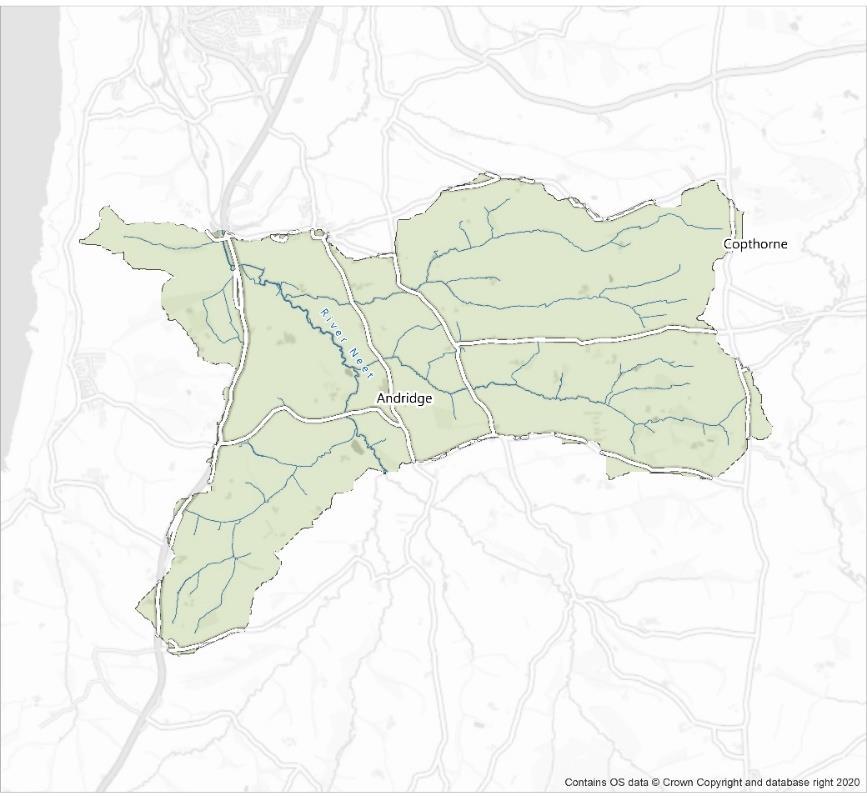Devon and Cornwall Soils Alliance









Lower River Neet – Business Case


Tim Martyn
February 2022
©Copyright Pierre Terre (CC BY-SA 2.0)1 Introduction
The following report provides a brief business case overview of the findings from the feasibility study area, which is one of nine across the Devon and Cornwall region funded by the Water Environment Grant (WEG). These waterbodies fail the WFD for sediment related issues and these business cases provide evidence as to type and location of soil and sediment issues, degree of farm advice and grant required to support business, regulatory issues/failings and whether current farming practices within the catchment are aligned with inherent land capability.

2 Lower River Neet
2.1 Background
The Lower River Neet is located on the north coast of Cornwall (Figure 1), it is fed by two upstream catchments (Upper River Neet and Jacobs Stream) and is approximately 1570ha. During the field observations undertaken for the feasibility study, it was confirmed the Lower River Neet was impacted by soil and sediment, which came from a number of different sources.
2.2 Deskbased study
Summary of the outputs from the WRT & EA GIS pack. These appear largely unreliable. The reasons for the failing status of the catchment appeared to be out of date and, possibly, wrongly attributed solely to agriculture. Sediment may at one time have come from agricultural activities but it seems that bankside erosion is significant again, caused by the river flood levels in the channel, in combination with a lack of appropriate bankside management for the situation that has developed over the last 50 years is responsible.
The failing status of the River now appears to be due to the presence of a fire retardant, which appears to be coming into the Catchment from upstream catchments
However, it was felt that though the land cover map from 2015 provided in the Map Pack was broadly accurate, it may have over-estimated the arable and horticultural land area compared to what was noted on the ground over the winter of 2020/21. Soil type, mineral composition and soil hydrology were all likely to be broadly accurate, being based on the Soil Survey of England and Wales.
2.3 Literature summary
Summary of the available literature that comes to light during the course of catchment investigations
Most farmers would be aware of the Agricultural and Horticultural development Board (AHDB) as a source of free advice and would probably attend an on-farm meeting if nearby or at a farm that was considered to be of particular interest due to size, novelty, reputation, etc. The agricultural machinery, chemical and fertiliser manufacturers, plant and animal breeders, etc., generally provide useful and accurate free information to support their products.
Summary limitations/strengths of literature (out of date/site specific etc.)
The literature provided by the various trades covering seed, fertiliser, agro-chemical, tyres, machinery (soil remediation and other equipment), grassland management, soil management, etc., is usually all very accurate, particularly if it is a national company which has, particularly in the past, invested in providing knowledge via literature to its customers, farmers. Government funded organisations such the National Soil Resources Institute (England), Scottish Rural Colleges, Teagasc (Eire), Agri-Food and Biosciences Institute (Northern Ireland) provide an excellent source of information relevant to UK conditions as does the Agricultural and Horticultural Development Board (England), in most cases, and Natural England, though online searching of publications can be difficult.
How useful?
The advisory literature provided by large national agricultural companies and Government funded organisations across the UK and Eire is a good source of free advice and very useful, to the extent that the more enthusiastic grassland farmers seeking advice use it and would not pay for advice. However, many farmers don’t have a great deal of time to source such information.
2.4 Fieldwork findings
With a near disappearance of dairy farming in the Lower River Neet catchment, the Soil Mentor estimated that only a small number of farms are impacting the whole catchment, which is in contrast to the other target catchments. No outwintering of cattle were noted and low level of sheep grazing over winter, soil compaction and runoff erosion due to livestock enterprises was considered low. However, a lack of slurry storage was considered to be an issue on some farms. As a result, poor timeliness of machinery field operations when land spreading may present
problems on occasion. Furthermore, post-harvest management of maize was an issue on one farm, where run-off erosion was observed.
River-bank erosion was considered to be a significant, though unquantified factor contributing to sediment being found in the river. Between Woolstone Bridge (Grid Ref.: SS22800187) and Helebridge (Grid Ref.: SS21460370) there were many instances of bank erosion, less where the riverbank was fenced. A potential secondary issue is now present, where it is possible that mature trees could topple into the channel, leaving soil exposed and highly vulnerable to erosion by river flows.
2.5 Regulation
The Soil Mentor was asked a series of questions that related to the issues and failings they observed in the catchment. These questions and the Soil Mentor’s responses are outlined in Table 1
In the Lower River Neet the Soil Mentor estimated that between 26-50% of the highlighted issues were classed as regulatory failings, when compared to the other catchments, this was the lowest. When asked about enforcement of the current regulations (Table 1, question 2), it was estimated that 100% of the issues could be improved with better regulation.
Of the issues highlighted in the feasibility report, what percentage of these issues would be classed as regulatory failings? E.g. SSAFO, FRFW, X compliance. Please note, this is for the % of issues highlighted, not the % of the whole catchment?
Would better enforcement of current regulations such as FRFW, X-compliance, NVZ work towards improving the issues highlighted?
2.6 Land capability and landuse type
Although there were issues in the catchment, according to the appointed Soil Mentor there was no evidence that the land use was not aligned with land capability.
2.7 Solutions and recommendation
In the feasibility report, in addition to better enforcement of regulations, further recommendations were suggested for the catchment, including;
- Advice on the financial impacts of poor soil management (e.g., aerating andlifting soils, contour strip cultivation of maize stubbles, nutrient planning);
- Enforcement which specifically relates to slurry storage;
- Grant schemes for capital work;
- Introduction of farming cooperatives to better manage selling prices.
Estimated cost of remediation
The approximate costs of addressing the pollution issues in the catchment are shown in Table 2.
Table 2 – estimated costs and cost category for the recommended work in the Lower River Neet catchment.
Cost of suitably qualified farm advisor 0.5 FTE
A simple earth-banked slurry store of 3250 m3 capacity
Best practice soil management aerating and lifting soils, contour strip cultivation of maize stubbles, nutrient planning
Cost not specified
£10,000 to £30,000 per farm. Actual cost depends on individual farm requirements.
Low cost implementation – suggested that these cost could be absorbed by the farmers themselves
Total cost < 250k (small)
2.8 Risks and barriers associated with solutions
The high impact risks associated with the approaches identified by the Soil Mentor included:
- Cost of slurry storge installation;
- Appropriate weather and soil conditions to allow implementation of best practice soil management.
2.9 Benefits of change
In terms of soil management for this catchment there may, currently, be little to improve upon except for post-harvest management of maize. Further instruction on soil management may help to educate and prevent issues in the future when coupled with enforcement.
A lack of slurry storage may be attended to if the grant scheme proposed by the Government leads to new and improved storage facilities allowing farms to meet the minimum standard of storage for the relevant legislation. This could be delivered with soil management advice and would relieve the pressure to spread when soil and crop growth conditions are inappropriate.
2.10 Lessons learnt
The catchment was selected as it was judged to be failing on water quality due to sediment, measured historically. The location of the sampling point is not apparent and it is speculated that the Upper Neet and the River Strat, which were not part of the study, may have been and continue to be contributing factors. The local knowledge of the catchment surveyor in this exercise identified situations in those catchments outside of the Lower Neet that may have been contributing sediment historically as well as currently. These situations included late sown, poorly established winter cereals and maize stubbles left bare.
